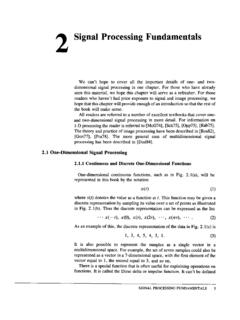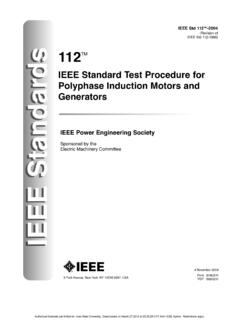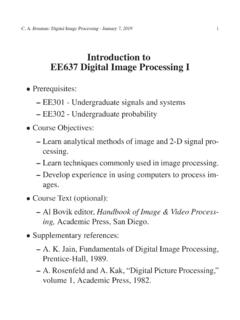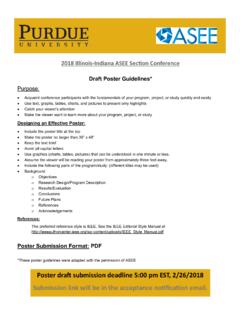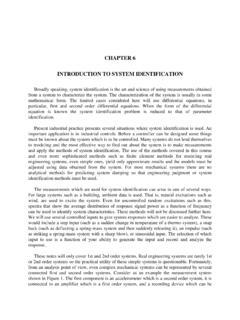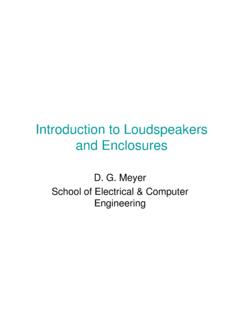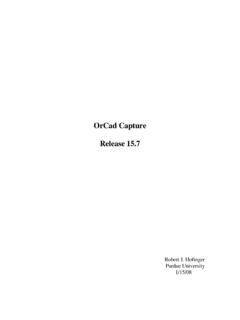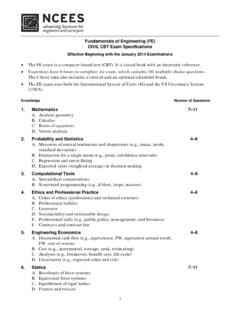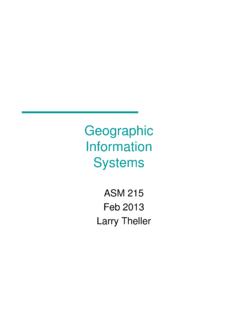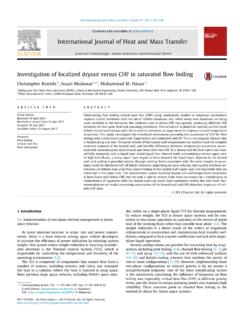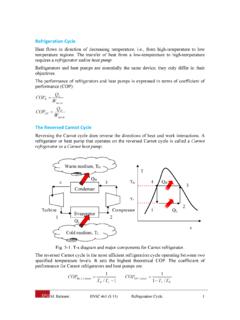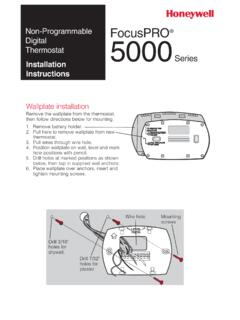Transcription of ME 200 Thermodynamics 1 Fall 2017 – Exam 3
1 Last Name:_____ First Name: _____Thermo no. _____ ME 200 Thermodynamics 1 fall 2017 Exam 3 Circle your instructor s last name Division 1: Naik Division 2: Sojka Division 3: Wassgren Division 4: Goldenstein Division 6: Braun Division 7: Buckius Division 8: Meyer INSTRUCTIONS This is a closed book and closed notes exam. Equation sheets and all needed tables are provided. Significant credit for each problem is given if you identify your system and its boundary, draw the relevant energy flows on a diagram Energy Flow Diagram (EFD), start your analysis with the basic equations, list all relevant assumptions, and have appropriate units and use three significant figures. There is no need to re-write the given and find. Do not hesitate to ask if you do not comprehend a problem statement.
2 For your own benefit, please write clearly and legibly. You must show your work to receive credit for your answers. Do not write on the back of any page because it will not be scanned so will not be graded. If you need extra paper raise your hand and a proctor will supply it. IMPORTANT NOTE The use of PDAs, Blackberry-type devices, cell phones, laptop computers, smart watches or any other sources of communication (wireless or otherwise) is strictly prohibited during examinations. Doing so is cheating. If you bring a smart watch, cell phone, or other communication device to the examination, it must be turned off prior to the start of the exam, placed in your backpack, and the backpack must be stored below your seat. It shall be reactivated only after you leave the examination room for the final time.
3 Otherwise it is a form of cheating and will be treated as such. SECOND IMPORTANT NOTE The only calculators allowed for use on this exam are those of the TI-30X series. No others. Last Name:_____ First Name: _____Thermo no. _____ 1. [20 points] Circle the correct answer (no partial credit) for each. (a) Entropy of air treated as an ideal gas depends only on temperature. (True or False) (b) Enthalpy of air treated as an ideal gas depends only on temperature. (True or False) (c) Enthalpy of water treated as an incompressible substance depends only on temperature. (True or False) (d) Heat transfer is always zero during an isothermal process. (True or False) (e) The entropy change of a substance undergoing an internally reversible process is always zero. (True or False) (f) Entropy of a fluid undergoing an adiabatic, steady-state throttling process using a flow restriction ( valve) device (Increases, Decreases, Remains the Same) (g) Entropy of water treated as an incompressible substance undergoing an isothermal process (Increases, Decreases, Remains the Same) (h) Entropy of a pure substance undergoing a phase change from saturated vapor to saturated liquid at constant pressure (Increases, Decreases, Remains the Same) (i) Change in entropy of a fluid having undergone a complete cycle in a reversible Carnot heat engine is (Positive, Negative, Zero) (j) Change in entropy of a fluid having undergone a complete cycle in an irreversible heat engine is (Positive, Negative, Zero) Last Name:_____ First Name.
4 _____Thermo no. _____ 2. [40 points] A piston-cylinder device contains kg of air initially at a temperature of 27 C and an absolute pressure of 1 bar (State 1). The air undergoes a compression process, where = constant, until the volume is 20% of the initial volume and the absolute pressure is bar (State 2). During the compression process, kJ of work is done on the air. The cylinder is fitted with a cooling water jacket all around its outer wall. The cooling water jacket contains kg of liquid water . The water is initially at a temperature of 25 C and an absolute pressure of 1 bar (State 3) at the start of the air compression process. Heat transfer occurs only between air in the cylinder and water inside the cooling jacket since the water jacket is perfectly insulated on its outside.
5 Molecular weight of air: kg/kmol Specific heat of liquid water : kJ/kg-K Use the closest value in ideal gas table; do not interpolate. (a) What is the final temperature ( C) of water during the compression process? (b) Calculate the entropy change (kJ/K) for the air. (c) Find the entropy change (kJ/K) for the water . (d) Determine the entropy generation for the entire process (both air and water ). Identify appropriate system or systems on the sketch provided, show mass/energy interactions (EFD), list any assumptions and basic equations, and provide your solution. There is no need to re-write the given and find. Last Name:_____ First Name: _____Thermo no. _____ Extra Space for Problem 2 Assumptions Quasi-equilibrium Ignore KE change Ignore PE change Neglect friction No other work except boundary work Air is an ideal gas Liquid water is an incompressible liquid Specific heat of liquid water remains constant with temperature change Basic Equations Integrating: QW U KE PE ,jin inout outgenerationjinoutsystemj boundaryQdSmsm sdtT Integrating: boundaryQST Solution (a) Initial volume of air in the cylinder: kg 273 m100 kPaairairairairRmTMmRTVPP Final volume of air in the cylinder: mVV Final temperature of air in the cylinder: 222airairPVTmR Final temperature of air in the cylinder: 32810 kPa m486 kg 11kJ300 and 22kJ490 inoutinoutinoutsystemdEQ Wm h ke pemh ke pedt Last Name:_____ First Name.
6 _____Thermo no. _____ Extra Space for Problem 2 Considering air inside the cylinder as the system, heat transfer during the compression process: kJ kJkgairQW UUmuu Considering liquid water inside the cooling jacket as the system during the polytropic compression process: 3434434343waterwaterwaterQW UUm uu mC TT Heat transfer from air occurs only to the liquid water in the cooling jacket since the outside of the cooling jacket is perfectly insulated 341210 kJQQ Temperature change of liquid water during the compression process: 344310 kg Final temperature of water : CT (b) Entropy change for the air: ln1barkg-KairairairPSmssRP (c) Entropy change for the water : 273 kg 273 KwaterwaterwaterTSmCT (d) Considering air in the cylinder and liquid water inside the cooling jacket as the combined system, entropy generation for the entire process: airwaterboundaryQSSST Last Name:_____ First Name: _____Thermo no.
7 _____ 3. [40 points] A solar-powered steam power plant uses the sun s radiation to boil water . At peak operating conditions, the rate of radiation heat transfer into the boiler is 420 MW. The working fluid is water /steam, with data at each state provided in the table below; all the pressure values are absolute. State P, bar T, C h, kJ/kg , m3/kg s, kJ/kg-K 1 10 2 40 3 40 600 3675 4 10 2270 P, bar Tsat, C hf, kJ/kg hg, kJ/kg sf, kJ/kg_Ksg, kJ/kg_K 10 40 (a) Calculate the steam mass flow rate (kg/s) through the boiler.
8 (b) Compute the isentropic efficiency (%) of the adiabatic turbine. (c) Find the entropy generation (kW/K) for the adiabatic turbine. (d) Determine the total entropy generation (kW/K) for the condenser assuming heat transfer occurs to an environment of temperature 5 C. (e) Show the cycle on T-s diagram relative to the vapor dome and the relevant lines of constant pressure. Label the axes and four states and indicate the process directions with arrows. Critical temperature and pressure of water are 374 C and 221 bar, respectively. 2m 4m 3m turbineW boilerQ condenserQ 1m 4m 5 C278 KboundaryenvironmentTT Last Name:_____ First Name: _____Thermo no. _____ Extra Space for Problem 3 Assumptions Quasi-equilibrium Steady state, steady flow One-dimensional, uniform flow Ignore KE change Ignore PE change Boiler: 0 CVW Turbine and Pump: 0 CVQ Basic Equations ,jin inout outgenerationjinoutsystemj boundaryQdSmsm sdtT Solution (a) Mass balance for the boiler: 23steammmm Energy balance for the boiler: 32boilersteamQmhh Mass flow rate of steam through the boiler: 332kJ420 10skJ3675 (b) Mass balance for the turbine: 34steammmm Energy balance for the actual turbine: 34kJkJ3675 22701405kgkgactualwhh For the isentropic process through the turbine: sf,10 C < s4s < sg,10 C saturated liquid-vapor mixture For saturated liquid-vapor mixture.
9 4,10 C4,10 C,10 inoutinoutinoutsystemdEQ Wm h ke pemh ke pedt inoutinoutsystemdmmmdt Last Name:_____ First Name: _____Thermo no. _____ Extra Space for Problem 3 Energy balance for the isentropic turbine: 34kJkJ3675 20861589kgkgisentropicswhh Isentropic efficiency of the turbine: kJ1405kgkJ1589kgactualturbineisentropicw w (c) Mass balance for the turbine: 34steammmm Entropy balance for the actual turbine: (d) Mass balance for the condenser: 41steammmm Energy balance for the condenser: 2270skgcondensersteamQmhh kJ257, 780scondenserQ Entropy balance for the condernser: 14257, 780 273 Kskg-KcondensercondensersteamboundaryQms sT (e) T-s diagram 4,10 C444,10 C,10 42kgsfsssgfhhhxhhh T(C)s(kJ/kg-K) P4= P1= barT1= T4= 10C3P2= P3= 40 barT3= 600C12s2= s1= s2s= 2s4s4s3= s4s= s4= T2=
